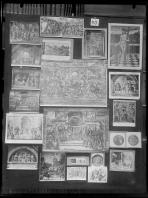The left side of the panel is devoted to images from Ghirlandaio’s frescoes in St. Maria Novella, commissioned in 1485 by the Florentine merchant and banker Giovanni Tornabuoni. The two main narrative cycles are devoted to the lives of the Virgin Mary and Saint John the Baptist.
The compositional similarities between the different scenes in images #1, 2, 3, 4.1, 4.2 & 5 shouldn't surprise at all, since they belong to the same decorative program. Yet it is important to mark their cardinal features, as they stand in clear contrast to the following sequences. First, all scenes are clearly localized and feature very elaborate architectural backgrounds formed by triumphal archs, exterior and interior, sacred and profane spaces. All of these spaces are designed as open structures, organised by somewhat rigid central perspectives. Their appearance is quite balanced and level-headed, while the “triumphal-arch pathos,” one might conclude, is confined to the decorations of these solemn structures, or at least delegated to other accessory elements (as will also be the case with the figure of the famous “Nymph” in panel 47). Second, all of the chosen scenes show a de-centered narrative. None of them permits the narrative to culminate at the vanishing point of the composition, e.g. by staging a heroic figure in the middle of the composition – in stark opposition to the later sequences of the panel.
In the light of the polar dichotomy articulated in the first sequence, which consists of the two central images, it becomes clear that this sequence on the left tends towards the balanced pole represented by the Apparition of the Angel to Zacharias (#4.2). Indeed, this scene is even repeated twice on the lefthand side, first by a second copy of the same photograph presented in the first sequence (#4.1), and second by a preparatory drawing for the respective mural (#5).
